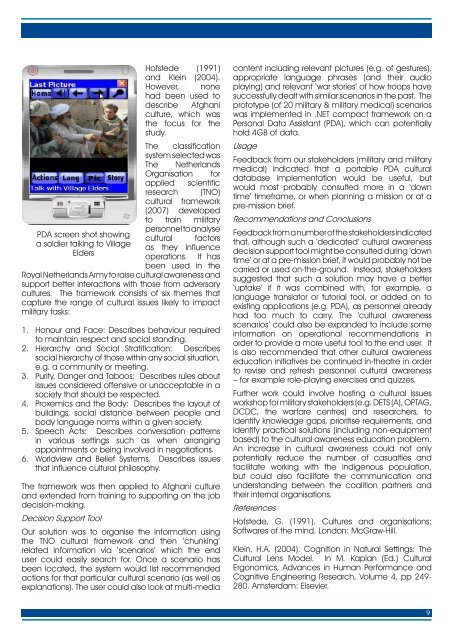Frontline Issue 09 - Human Factors Integration Defence Technology ...
Frontline Issue 09 - Human Factors Integration Defence Technology ...
Frontline Issue 09 - Human Factors Integration Defence Technology ...
Create successful ePaper yourself
Turn your PDF publications into a flip-book with our unique Google optimized e-Paper software.
Hofstede (1991)and Klein (2004).However, nonehad been used todescribe Afghaniculture, which wasthe focus for thestudy.The classificationsystem selected wasThe NetherlandsOrganisation forapplied scientificresearch (TNO)cultural framework(2007) developedto train militarypersonnel to analysecultural factorsas they influenceoperations. It hasbeen used in theRoyal Netherlands Army to raise cultural awareness andsupport better interactions with those from adversarycultures. The framework consists of six themes thatcapture the range of cultural issues likely to impactmilitary tasks:1.2.3.4.5.6.PDA screen shot showinga soldier talking to VillageEldersHonour and Face: Describes behaviour requiredto maintain respect and social standing.Hierarchy and Social Stratification: Describessocial hierarchy of those within any social situation,e.g. a community or meeting.Purity, Danger and Taboos: Describes rules aboutissues considered offensive or unacceptable in asociety that should be respected.Proxemics and the Body: Describes the layout ofbuildings, social distance between people andbody language norms within a given society.Speech Acts: Describes conversation patternsin various settings such as when arrangingappointments or being involved in negotiations.Worldview and Belief Systems. Describes issuesthat influence cultural philosophy.The framework was then applied to Afghani cultureand extended from training to supporting on the jobdecision-making.Decision Support ToolOur solution was to organise the information usingthe TNO cultural framework and then ‘chunking’related information via ‘scenarios’ which the enduser could easily search for. Once a scenario hasbeen located, the system would list recommendedactions for that particular cultural scenario (as well asexplanations). The user could also look at multi-mediacontent including relevant pictures (e.g. of gestures),appropriate language phrases (and their audioplaying) and relevant ‘war stories’ of how troops havesuccessfully dealt with similar scenarios in the past. Theprototype (of 20 military & military medical) scenarioswas implemented in .NET compact framework on aPersonal Data Assistant (PDA), which can potentiallyhold 4GB of data.UsageFeedback from our stakeholders (military and militarymedical) indicated that a portable PDA culturaldatabase implementation would be useful, butwould most probably consulted more in a ‘downtime’ timeframe, or when planning a mission or at apre-mission brief.Recommendations and ConclusionsFeedback from a number of the stakeholders indicatedthat, although such a ‘dedicated’ cultural awarenessdecision support tool might be consulted during ‘downtime’ or at a pre-mission brief, it would probably not becarried or used on-the-ground. Instead, stakeholderssuggested that such a solution may have a better‘uptake’ if it was combined with, for example, alanguage translator or tutorial tool, or added on toexisting applications (e.g. PDA), as personnel alreadyhad too much to carry. The ‘cultural awarenessscenarios’ could also be expanded to include someinformation on operational recommendations inorder to provide a more useful tool to the end user. Itis also recommended that other cultural awarenesseducation initiatives be continued in-theatre in orderto revise and refresh personnel cultural awareness– for example role-playing exercises and quizzes.Further work could involve hosting a cultural issuesworkshop for military stakeholders (e.g. DETS (A), OPTAG,DCDC, the warfare centres) and researchers, toidentify knowledge gaps, prioritise requirements, andidentify practical solutions (including non-equipmentbased) to the cultural awareness education problem.An increase in cultural awareness could not onlypotentially reduce the number of casualties andfacilitate working with the indigenous population,but could also facilitate the communication andunderstanding between the coalition partners andtheir internal organisations.ReferencesHofstede, G. (1991). Cultures and organisations:Softwares of the mind. London: McGraw-Hill.Klein, H.A. (2004). Cognition in Natural Settings: TheCultural Lens Model. In M. Kaplan (Ed.) CulturalErgonomics, Advances in <strong>Human</strong> Performance andCognitive Engineering Research, Volume 4, pp 249-280. Amsterdam: Elsevier.9
















